
Birth Control and Abortion
Since the Supreme Court Dobbs v. Jackson decision that overturned Roe v. Wade, the subject of the government’s role in abortion has been foreground in the public discourse. The Supreme Court effectively pushed the decision about abortion to the states, generating widespread debate.
Sixteen states have established new laws making abortion illegal at any point in the pregnancy, or reinstating such laws that were in place before the Roe v Wade decision. On the other hand, the voters of the relatively conservative state of Kansas rejected a ballot initiative which would have removed protections for abortion from their state’s constitution.
Reducing the number of abortions through means other than criminalization have been subjects of public debate for decades, including increasing the use of birth control or putting up more requirements to getting an abortion. Such policies have largely been crafted and implemented on the state level, with more liberal states preferring the birth control route and more conservative states preferring the abortion regulations route.
- National Sample: 2,604 registered voters
- Fielded: September 16-26, 2022
- Questionnaire with Frequencies
- Full Report
- Policymaking Simulation
Proposals with bipartisan support discussed below include:
- Requiring education about birth control in public schools
- High priority for the government to increase access to birth control
- Continuing to mandate insurance coverage of long-term birth control
- Subsidizing birth control for low-income and uninsured women
- Requiring the viewing of an ultrasound image of the fetus before an abortion
- Not making abortion a crime at any stage of pregnancy
- Not making abortion a crime before fetal viability
- Do NOT allow states to criminalize crossing state lines to get an abortion
Proposals that did not get bipartisan support:
- Continuing to prohibit the federal government from funding abortions (Hyde Amendment)
- Requiring doctors wait 1-3 days after approving an abortion before the abortion can be provided
For each proposal, respondents evaluated arguments for and against, rated the proposal on an eleven-point scale of acceptability (with 5 being “just tolerable”), and then made their final recommendation.
Reducing Unintended Pregnancies

Respondents evaluated a series of current or possible government efforts for reducing unintended pregnancies, and ultimately the number of abortions, that do not entail criminalization. Respondents were provided a briefing on unintended pregnancies, as follows:
As you likely know, many abortions are performed because the woman did not intend to become pregnant. More than 4 in 10 pregnancies are unintended. Two ways that the government currently tries to reduce the number of unintended pregnancies are:
- Teaching sex education in schools, which include information about birth control
- Helping people to get birth control by making it easier to get and more affordable
They were also briefed on access to long-term birth control:
Another way that the government could reduce unintended pregnancies, and ultimately abortions, would be by making it more possible for women to get long-term birth control. Long-term birth control refers to methods that require a prescription, such as the pill, implants and intra-uterine devices or IUDs.
Currently, the government makes it more possible for women to get long-term birth control by requiring that it be covered by most private insurance and all state-run public health insurance programs (including Medicaid). There are exemptions for nonprofits, religious organizations, and closely-held companies led by people morally opposed to birth control.
Even though birth control must be covered by most private insurance, as well as public insurance (e.g. Medicaid), birth control can still be difficult to afford for some women:
- Around 7.5 million women of reproductive age (15-44) do not have insurance.
- Many insurance companies limit their coverage of birth control pills to certain types. For each type some women get negative side effects, thus they are effectively excluded from coverage.
Thus, some state governments have tried to help some of these women get access to birth control by providing funds to health care clinics so they can provide long-term birth control for free or at a low cost.



Respondents were presented the following:
First, let’s look at education about birth control as a means for reducing unintended pregnancies and ultimately abortions.
Currently, about 40% of public school students do not receive sex education programs that teach about birth control.
Research on the effect of sex education programs has found that programs that include information about birth control are effective in reducing unintended teen pregnancies. These effects tend to decline after a couple years though.
They were told that one proposal is to “require all sex education programs in public schools to include information about birth control.”
Respondents evaluated two pairs of pro and con arguments. The arguments in favor were found convincing by 76-86%, including very large majorities of Republicans and Democrats. The arguments against were found convincing by less than half, including under half of Democrats, but modest majorities of Republicans.
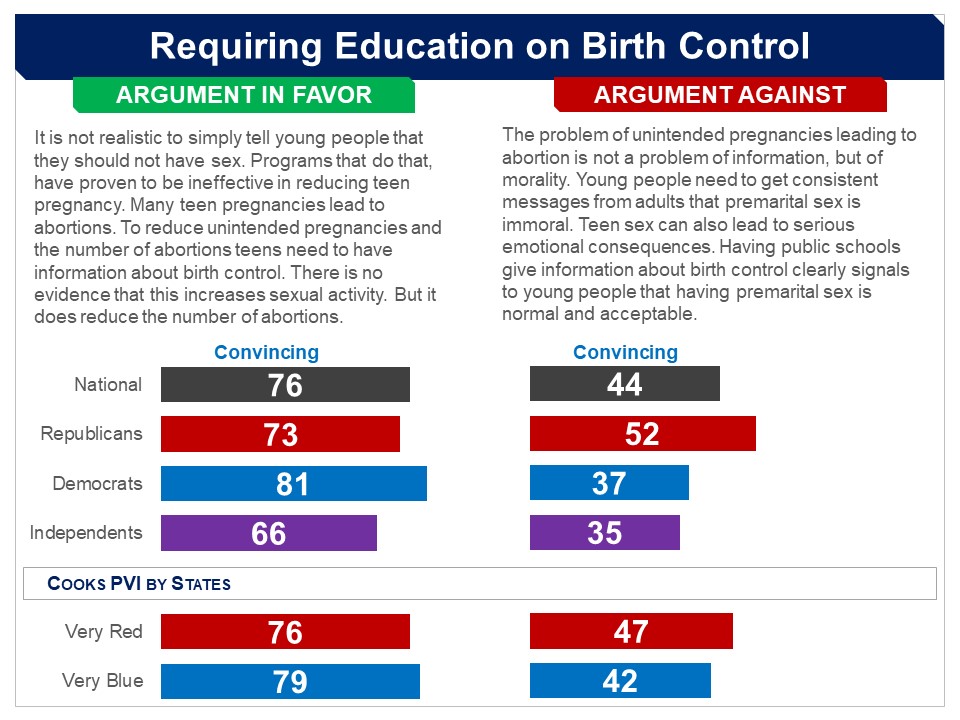
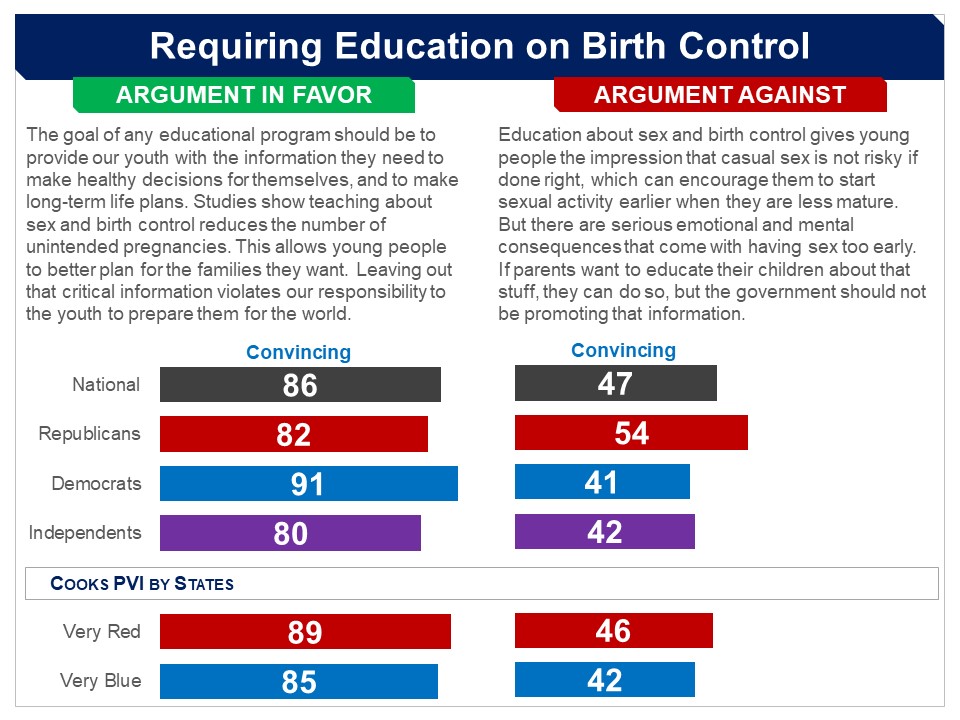 Asked for their final recommendation, a very large bipartisan majority (78%) favored the government requiring that public schools provide education to students about birth control, including 71% of Republicans and 86% of Democrats. Majorities in all types of Congressional districts were in favor, from very red (78%) to very blue (82%).
Asked for their final recommendation, a very large bipartisan majority (78%) favored the government requiring that public schools provide education to students about birth control, including 71% of Republicans and 86% of Democrats. Majorities in all types of Congressional districts were in favor, from very red (78%) to very blue (82%).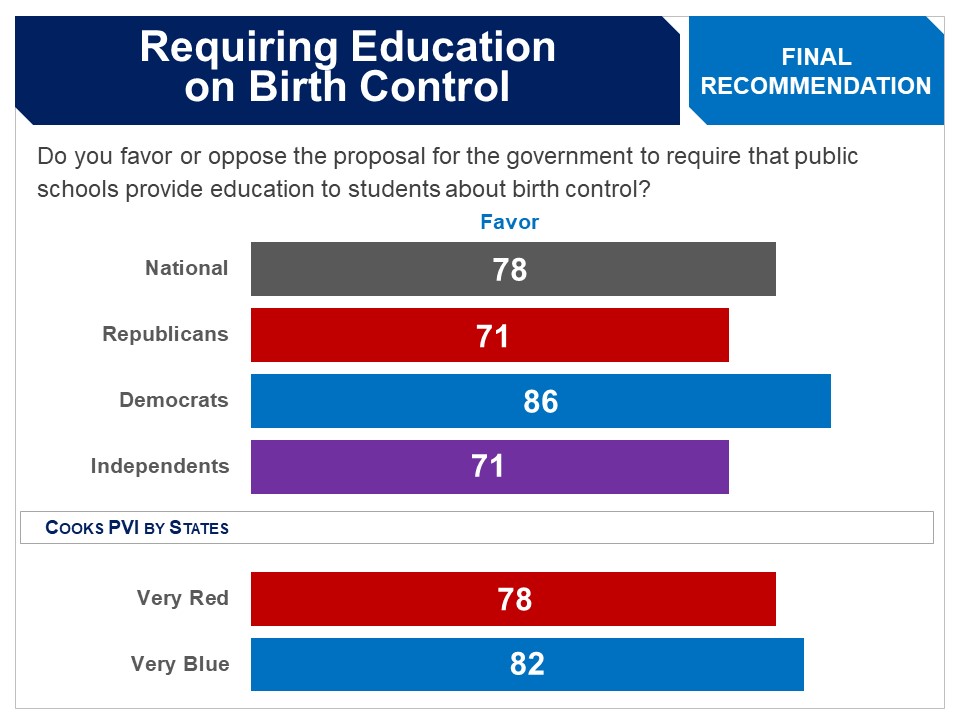



Respondents first evaluated competing arguments over the general principle of “whether the government should seek to reduce unintended pregnancies by making it more possible to get birth control.”
The argument in favor was found convincing by an overwhelming bipartisan majority (85%, Republicans 82%, Democrats 90%). The argument against was found convincing by less than half (43%, Republicans 49%, Democrats 38%).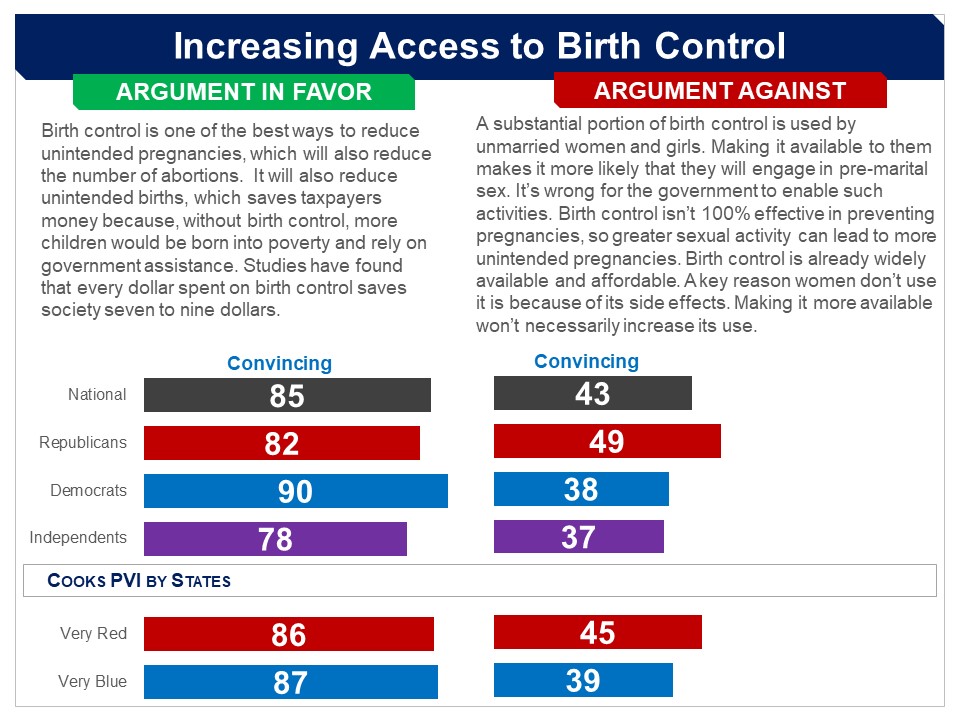 They were then asked whether they favor or oppose, “the government making it a higher priority to reduce unintended pregnancies by making it more possible to get birth control.” A very large bipartisan majority of 79% were in favor, including majorities of Republicans (73%) and Democrats (87%). Majorities in all types of Congressional districts were in favor, from very red (75%) to very blue (82%).
They were then asked whether they favor or oppose, “the government making it a higher priority to reduce unintended pregnancies by making it more possible to get birth control.” A very large bipartisan majority of 79% were in favor, including majorities of Republicans (73%) and Democrats (87%). Majorities in all types of Congressional districts were in favor, from very red (75%) to very blue (82%).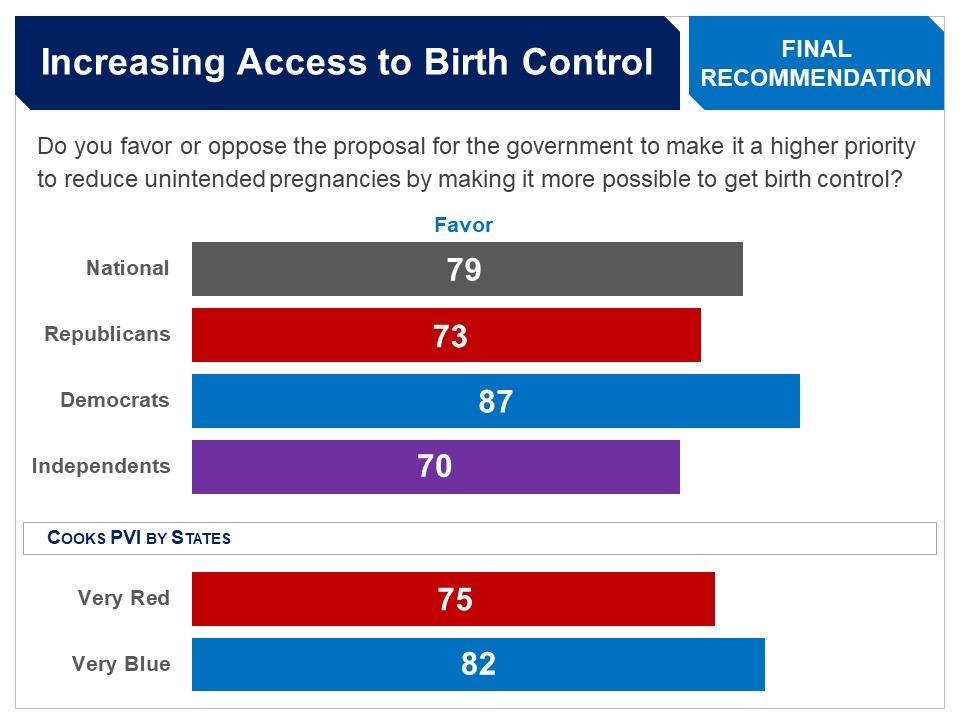



The first policy proposal for ensuring access to birth control was about insurance coverage of birth control. Respondents were introduced to the topic, as follows:
As you may know, the federal government currently requires that private health insurance and state-run public health insurance (including Medicaid) cover all forms of long-term birth control such as the pill and IUDs. For private health insurance there are exemptions for nonprofits, religious organizations, and closely-held companies led by people morally opposed to birth control.
They evaluated arguments over, “whether the government should continue to require (with some religious and moral exemptions for some employers) that health insurance covers long-term birth control.”
The argument in favor was found convincing by a very large bipartisan majority (80%, Republicans 77%, Democrats 85%). The argument against was found convincing by less than half (48%), including just 41% of Democrats, but a majority of Republicans (57%).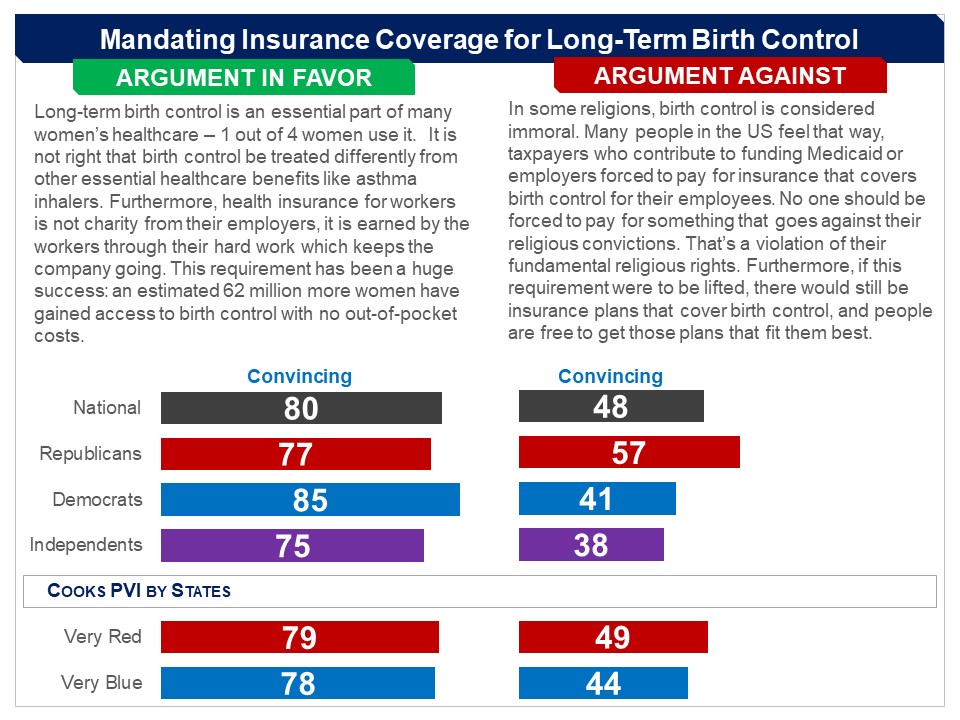 Asked for their final recommendation, a very large bipartisan majority (82%) approved of, “the federal government continuing to require that health insurance covers long-term birth control (with some religious and moral exemptions for some employers),” including 76% of Republicans and 90% of Democrats. Majorities in all types of Congressional districts were in favor, from very red (83%) to very blue (85%).
Asked for their final recommendation, a very large bipartisan majority (82%) approved of, “the federal government continuing to require that health insurance covers long-term birth control (with some religious and moral exemptions for some employers),” including 76% of Republicans and 90% of Democrats. Majorities in all types of Congressional districts were in favor, from very red (83%) to very blue (85%).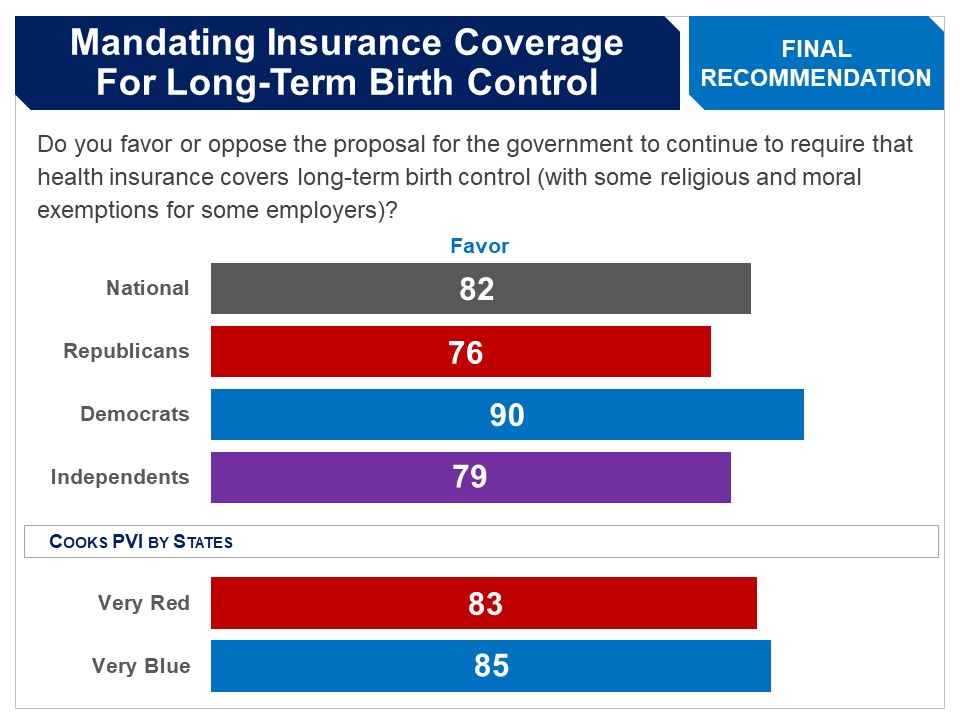 Standard Polls
Standard Polls
Large majorities, driven primarily by Democrats, have supported the Affordable Care Act requirement that health insurance plans cover birth control. Among Republicans, no more than half have been opposed:
- Asked whether they favor, “requiring private health insurance plans to cover the full cost of birth control,” and given a neutral middle option, 62% were in favor, including 77% of Democrats and 64% of independents. Among Republicans, 41% favored, 25% neither favored nor opposed and 33% opposed. (AP-NORC, April 2019)
- Told that, “with the exception of certain religious objections, employers are now required to cover the cost of preventive services including prescription birth control in their health plans,” respondents were asked if they support, “the health care law's requirement that private health insurance plans cover the full cost of birth control.” Overall 71% supported (party breakouts unavailable). (Kaiser Family Foundation, April 2017)
- Asked whether they support, “requiring employers to provide employees with health care plans that cover contraception or birth control at no cost,” 67% support, including 84% of Democrats and 67% of independents. Republicans are divided, with 48% in support and 50% opposed. (PRRI, February 2017)
- Told that they would be evaluating, “some elements of the 2010 health care law, known as Obamacare, respondents were asked if they favor including in a health care law, “requiring private health insurance plans to cover the full cost of birth control.” Overall, 65% were in support. Partisan breakouts were not provided. (AP-NORC, January 2017)



The next proposal to increase access to birth control concerned government subsidies to make birth control more affordable, primarily for low-income or uninsured women. Respondents were presented the following briefing:
As you may know, to increase access to birth control, some states provide funding to clinics to provide long-term birth control. However the federal government estimates that over half of women who are in need of government funded birth control – because they are low-income or uninsured – do not have access to it.
They were then told that there is a proposal to, “increase the amount of government funding to health care clinics so they can provide long-term birth control for free or at low cost for women who cannot get it some other way.”
The argument in favor was found convincing by a large bipartisan majority (81%, Republicans 75%, Democrats 87%). The argument against was found convincing by less than half (46%), including just 39% of Democrats, but a small majority of Republicans (54%).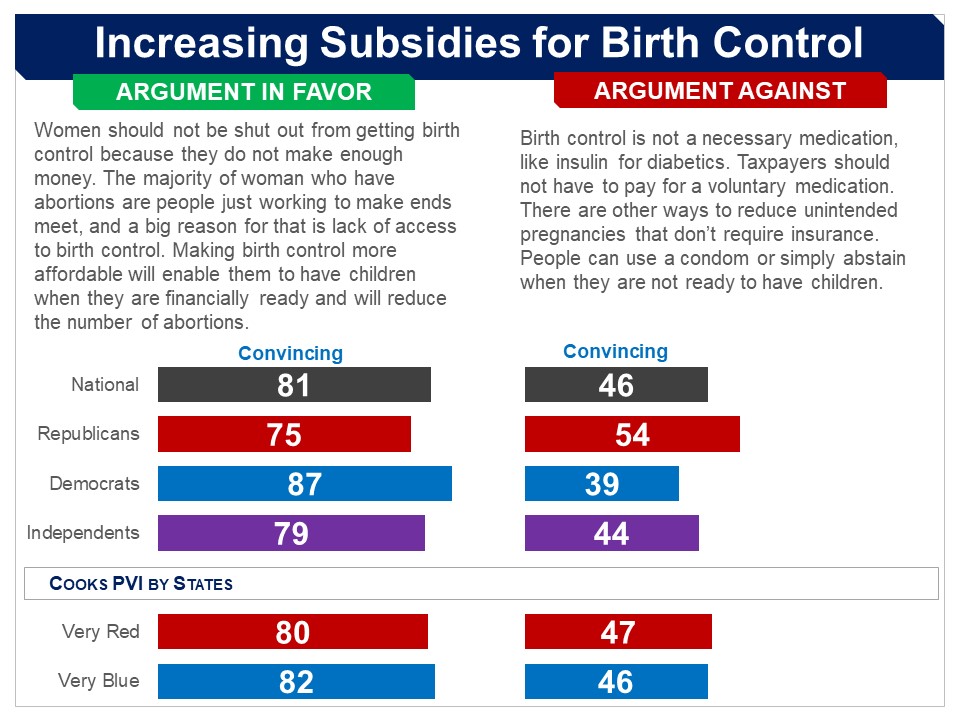 Asked for their final recommendation, a very large bipartisan majority (78%) favored, “iIncreasing the amount of government funding to health care clinics so they can provide long-term birth control for free or at low cost,” including 69% of Republicans and 87% of Democrats. Majorities in all types of Congressional districts were in favor, from very red (77%) to very blue (80%).
Asked for their final recommendation, a very large bipartisan majority (78%) favored, “iIncreasing the amount of government funding to health care clinics so they can provide long-term birth control for free or at low cost,” including 69% of Republicans and 87% of Democrats. Majorities in all types of Congressional districts were in favor, from very red (77%) to very blue (80%).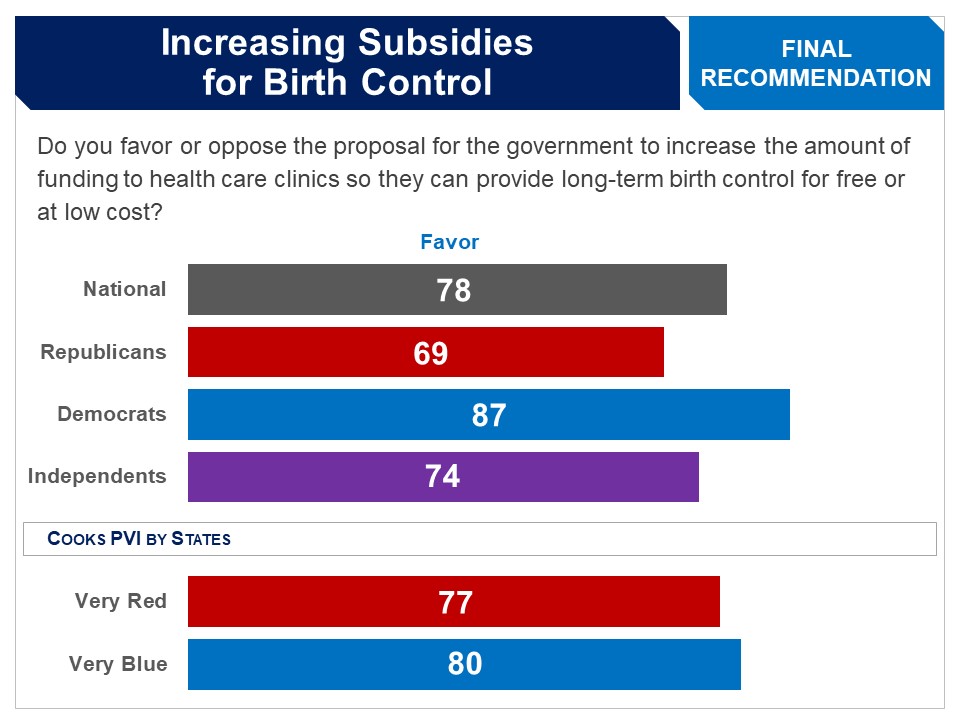 Related Standard Polls
Related Standard Polls
Large bipartisan majorities have supported the government subsidizing birth control for low-income and uninsured women:
- Asked how important it is that, “the federal government provides funding for reproductive health services, such as family planning and birth control for lower-income women,” (and given the option to say that it “should not be done”) 76% said it was very (60%) or somewhat (16%) important, including 93% of Democrats, 80% of independents and 52% of Republicans. Just 22% said it was not too important (8%) or should not be done (14%). (Kaiser Family Foundation, April 2019)
- Asked the same question two years earlier, 73% said important (Democrats 94%, independents 82%, Republicans 63%). (Kaiser Family Foundation, March 2017)
Increasing Barriers to Abortion



Respondents evaluated government policies intended to reduce abortions, “by putting more requirements on the process of a woman getting an abortion.” Respondents were told that:
This has been done at the state level in several ways, here are two of them:
- Requiring doctors to show a woman seeking an abortion an ultrasound image of her fetus (or read a description) before getting an abortion
- Prohibiting doctors from providing an abortion on the day that they approve it, but instead require the woman to come back 1-3 days later to get the abortion.
They then evaluated two pairs of arguments for and against the government putting more requirement on the process of getting an abortion. The first argument in favor was found convincing by a large bipartisan majority (70%, Republicans 80%, Democrats 62%). The argument against was also found convincing by a majority (59%), including 72% of Democrats, but under half of Republicans (47%).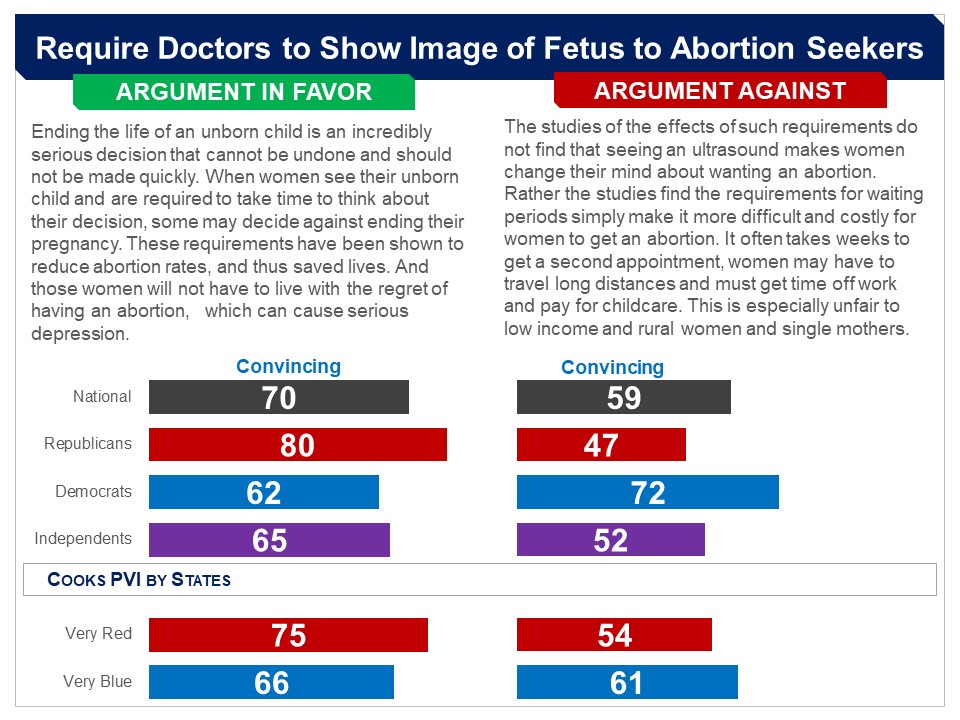 The second argument in favor was found convincing by a majority of 57%, including a large majority of Republicans (67%), but less than half of Democrats (48%). The second argument against was found convincing by a bipartisan majority (65%, Republicans 54%, Democrats 77%).
The second argument in favor was found convincing by a majority of 57%, including a large majority of Republicans (67%), but less than half of Democrats (48%). The second argument against was found convincing by a bipartisan majority (65%, Republicans 54%, Democrats 77%).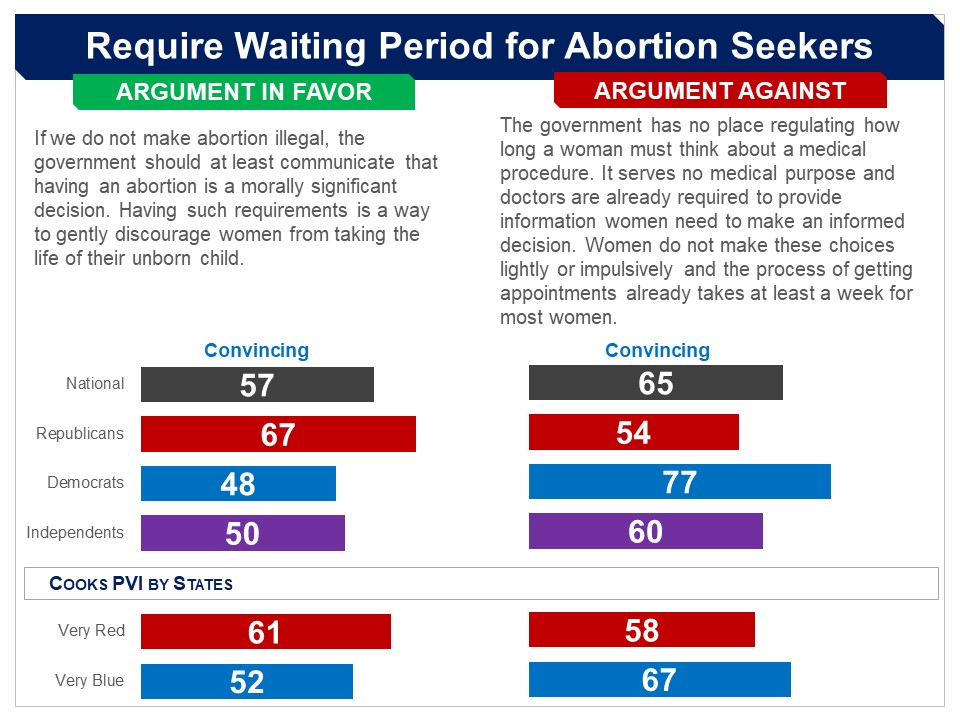 Respondents were then asked for their final recommendations on two proposals: mandatory ultrasounds and mandatory waiting periods.
Respondents were then asked for their final recommendations on two proposals: mandatory ultrasounds and mandatory waiting periods.
A majority of 58% favored, “requiring doctors to show a woman seeking an abortion an ultrasound image of her fetus (or read a description) before getting an abortion,” including 69% of Republicans and 51% of independents. Among Democrats, less than half were in favor (48%), but when asked how acceptable the policy is to them, a bare majority found it at least tolerable (52%). Majorities in all types of Congressional districts were in favor, from very red (65%) to very blue (55%).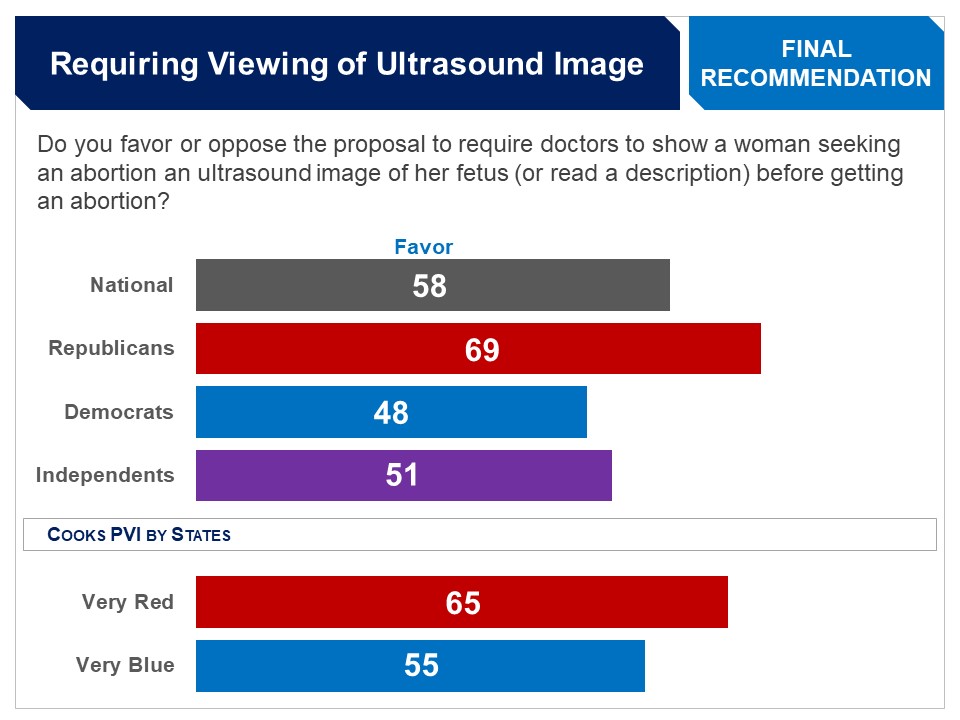 The proposal for “prohibiting doctors from providing an abortion on the day that they approve it, but instead require the woman to come back 1-3 days later to get the abortion,” was favored by a modest majority of 53%, including a majority of Republicans (64%), but less than half of Democrats (44%) and independents (48%). Asked how acceptable the policy would be, less than half (44%) said it would be tolerable or acceptable (6-10 on an eleven-point scale).
The proposal for “prohibiting doctors from providing an abortion on the day that they approve it, but instead require the woman to come back 1-3 days later to get the abortion,” was favored by a modest majority of 53%, including a majority of Republicans (64%), but less than half of Democrats (44%) and independents (48%). Asked how acceptable the policy would be, less than half (44%) said it would be tolerable or acceptable (6-10 on an eleven-point scale).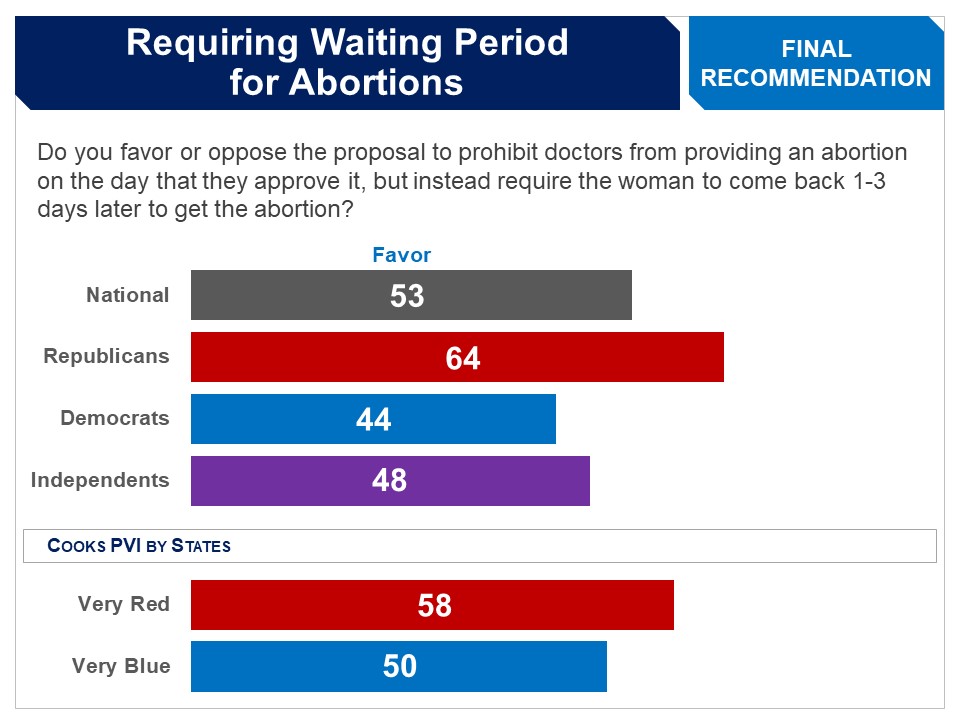 Demographic Differences
Demographic Differences
There were significant differences between men and women, with substantially fewer women in support of the above policies. Mandatory ultrasounds were favored by just half of women (50%), but two-thirds of men (66%); and mandatory waiting periods were favored by less than half of women (46%), but over six-in-ten men (62%).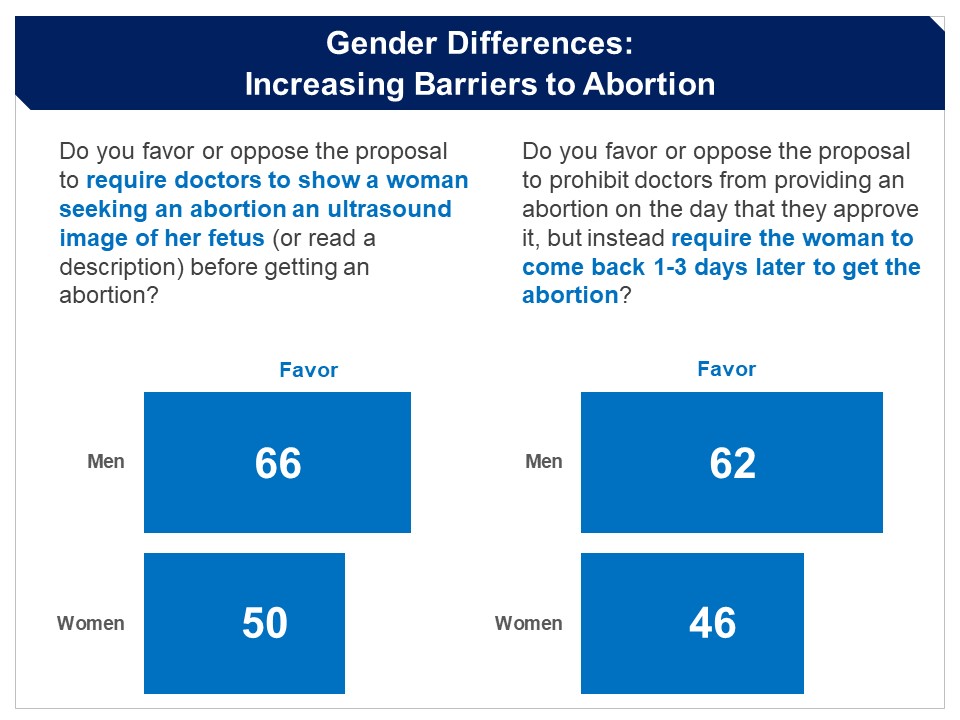 Related Standard Polls
Related Standard Polls
Small majorities have supported the requirement that doctors show or describe to women an ultrasound image of their fetus before they can provide an abortion, driven primarily by Republicans:
- Asked whether they support, “laws requiring doctors to show and describe ultrasound images to women seeking an abortion,” 57% were in support, including 83% of Republicans and 61% of independents, but just 34% of Democrats. (Kaiser Family Foundation, December 2019)
- Asked whether they support, “a law that requires women to be shown an ultrasound image at least 24 hours before an abortion procedure,” 52% were in support, including 73% of Republicans and 51% of independents, but just 36% of Democrats. (NPR/PBSNewsHour/Marist, June 2019)
Criminalizing Abortion
Respondents were first introduced to the possibility of the government criminalizing abortion, as follows:
Another way for the government to try to reduce the number of abortions is to make it a serious crime, which means:
- punishing a doctor who provides an abortion, either surgically or by providing pills; or
- punishing a woman who has an abortion with prison time and/or a major fine. Doctors could also lose their license.
Respondents were then presented a briefing on Supreme Court rulings regarding abortion, as follows:
As you may know, in 1973 the Supreme Court made a ruling on abortion in a case known as Roe v. Wade and then clarified in another decision called Casey v. Planned Parenthood. These rulings said that a woman has a right to get an abortion up to the time that the fetus is viable–meaning that the fetus could survive independent of the mother. Whether or not a fetus is viable was to be determined by the woman’s doctor. At the time Roe was decided, viability was generally considered to be around 28 weeks (on average, pregnancies last about 39 weeks). Due to medical advances, viability now occurs at 22-24 weeks. Nearly all abortions occur before this period.
States could then decide what limits to place after that period. Nearly all states had laws that made abortion illegal after the fetus was viable. The 1973 Supreme Court ruling also stated that, even after a fetus is determined to be viable, abortions cannot be banned when a doctor determines it is necessary to preserve the life or health of the woman. Around one percent of abortions occur after the fetus is viable. After the 1973 decision, the rate of abortions increased. Then in the 1980s the rate of abortions started to go down and has continued to decrease, going even lower than it was before 1973. Still, at current rates, it is estimated that around one in four women will have an abortion in their lifetime.
They were then told about the controversy surrounding the Roe v Wade decision and what the recent overruling in Dobbs v Jackson means, as follows:
As you probably know, the abortion rulings were very controversial. Over the last few decades there have been several lawsuits attempting to overturn those rulings, but none were successful. But this year, a lawsuit (known as Dobbs v. Jackson) was successful in getting the Supreme Court to overturn their previous abortion rulings. This means that it is now up to legislatures in the states, or Congress itself, to decide what the laws about abortion should be.
This has generated much debate in many states about what their abortion laws should be. Several states now have laws that make abortion a crime at any stage in pregnancy, while other states continue to allow abortion up until the fetus is viable. There has also been debate about whether there should be exceptions to any laws restricting access to abortion, such as if the life of the woman is at risk. We will come back to that question later.

Criminalizing Abortion
Respondents evaluated four pairs of arguments for and against the government criminalizing abortion:
The first argument in favor of criminalizing abortion, which proclaimed that abortion is murder and should be treated as such, was found convincing by a majority (54%), including a majority of Republicans (68%), but less than half of Democrats (42%). The first argument against, which countered that the government should stay out of it and not force a woman to give birth under threat of imprisonment, was found convincing by a large bipartisan majority (67%, Republicans 56%, Democrats 80%).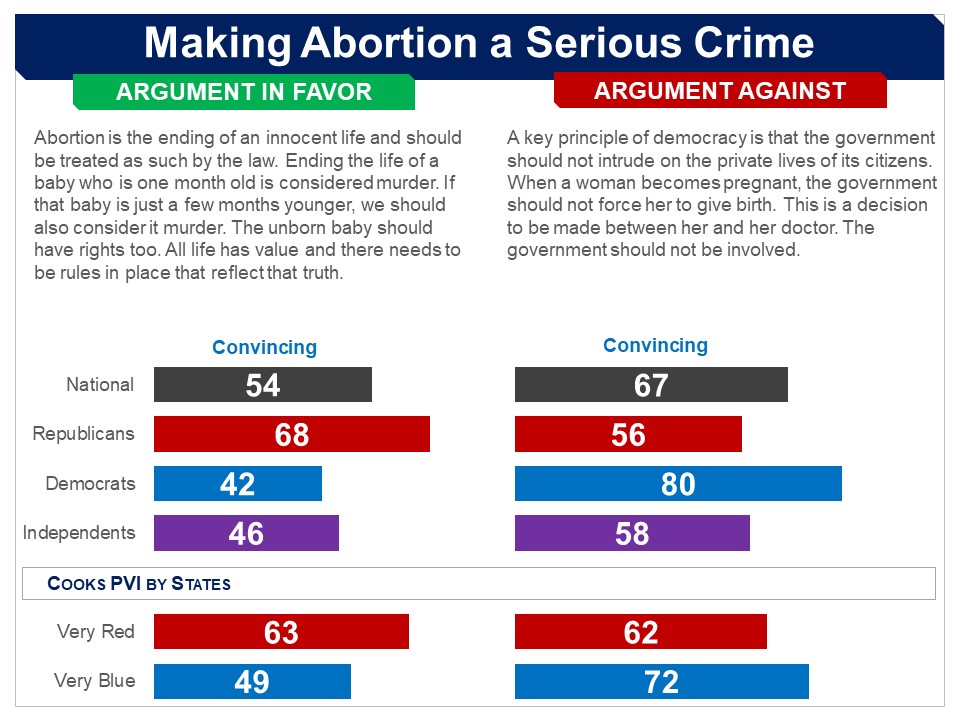 The second argument in favor emphasized that the government frequently steps in to reduce harm and that abortion is a harm to the unborn baby. This was found convincing by a majority of 55%, including a majority of Republicans (68%), but under half of Democrats (45%). The second argument against countered that there are more humane and effective ways to reduce abortion besides criminalization, and was found convincing by a large bipartisan majority (71%, Republicans 64%, Democrats 79%).
The second argument in favor emphasized that the government frequently steps in to reduce harm and that abortion is a harm to the unborn baby. This was found convincing by a majority of 55%, including a majority of Republicans (68%), but under half of Democrats (45%). The second argument against countered that there are more humane and effective ways to reduce abortion besides criminalization, and was found convincing by a large bipartisan majority (71%, Republicans 64%, Democrats 79%).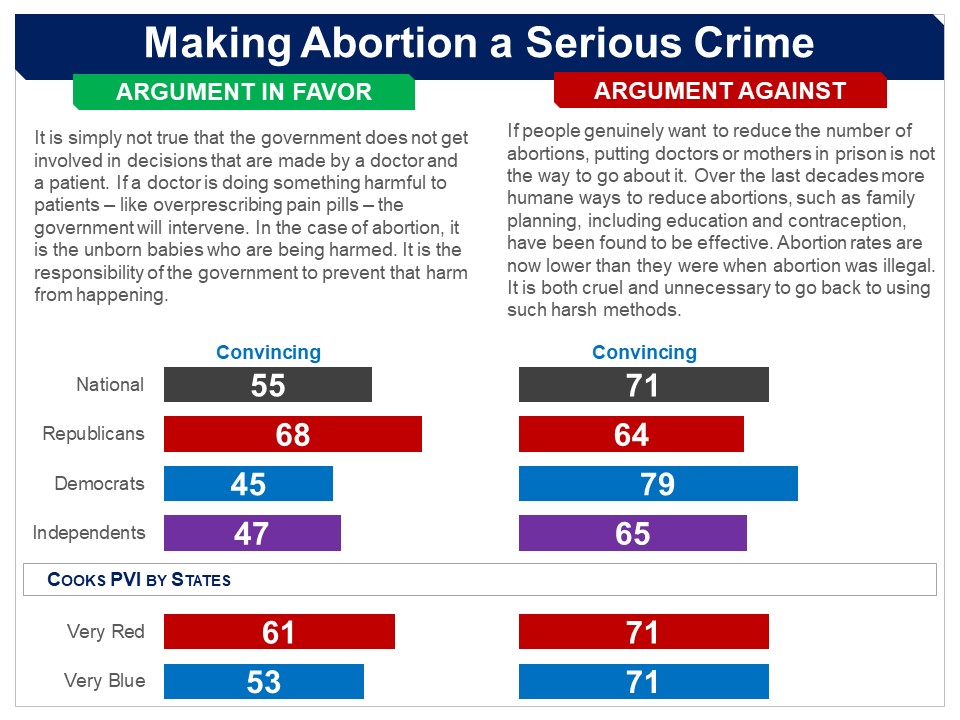 The third argument in favor responded to the previous one by asserting that we can have both family planning policies and abortion restrictions, and was found convincing by a majority of 58%, including 69% of Republicans and half of Democrats (50%). The third argument against underscored that criminalization has never worked to eliminate abortions, and was found convincing by a large bipartisan majority (68%, Republicans 59%, Democrats 79%).
The third argument in favor responded to the previous one by asserting that we can have both family planning policies and abortion restrictions, and was found convincing by a majority of 58%, including 69% of Republicans and half of Democrats (50%). The third argument against underscored that criminalization has never worked to eliminate abortions, and was found convincing by a large bipartisan majority (68%, Republicans 59%, Democrats 79%).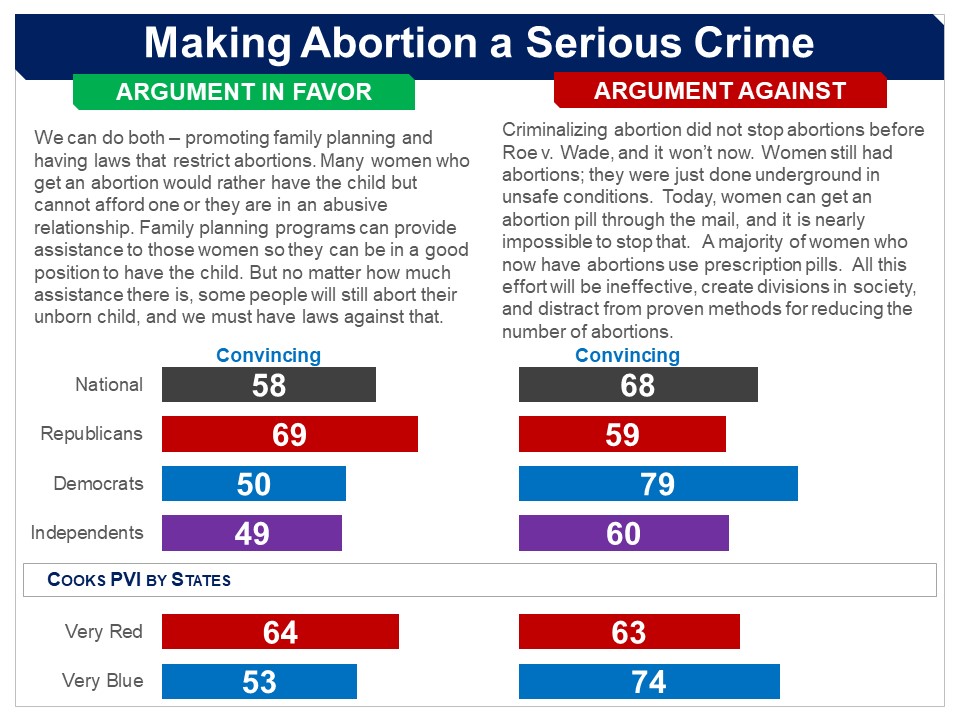 The final argument in favor responded to the previous one by proclaiming that our laws are never going to be perfect, but are meant to be a signal of our morals, and was found convincing by a small majority of 54%, including a majority of Republicans (67%), but less than half of Democrats (44%). The final argument against asserted that bodily autonomy is fundamental to all other freedoms, and was found convincing by a very large bipartisan majority (66%, Republicans 54%, Democrats 79%).
The final argument in favor responded to the previous one by proclaiming that our laws are never going to be perfect, but are meant to be a signal of our morals, and was found convincing by a small majority of 54%, including a majority of Republicans (67%), but less than half of Democrats (44%). The final argument against asserted that bodily autonomy is fundamental to all other freedoms, and was found convincing by a very large bipartisan majority (66%, Republicans 54%, Democrats 79%).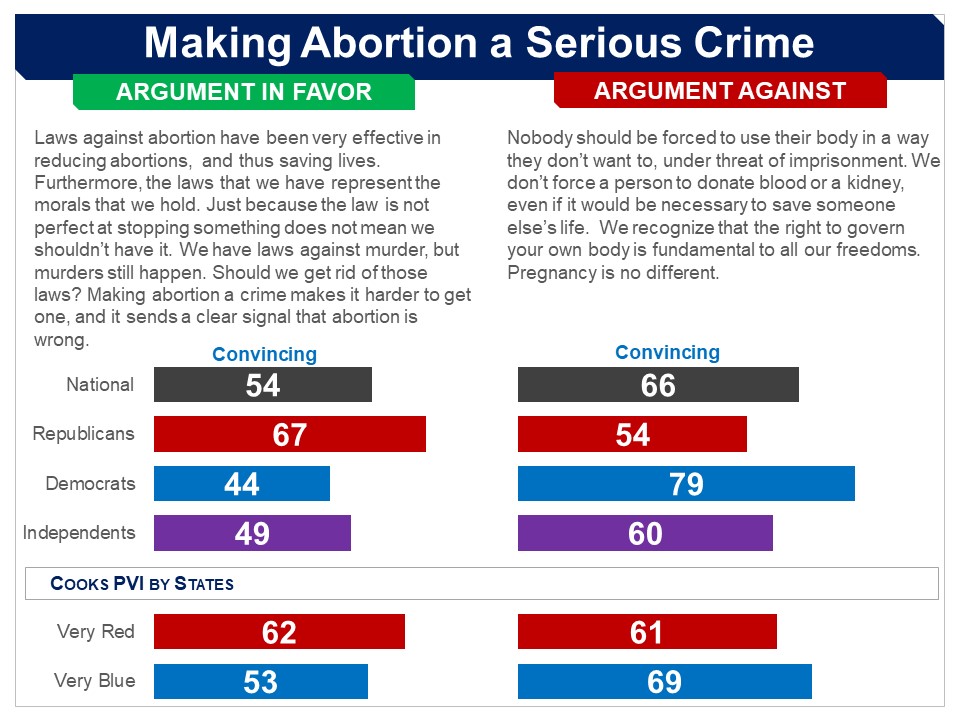 Criminalizing Abortion Only After Viability
Criminalizing Abortion Only After Viability
Respondents were introduced to the debate about whether abortion should only be criminalized after fetal viability, as follows:
Another debate is about the possibility of criminalizing abortions, but only when the fetus is viable (meaning they could survive outside the womb). This would be consistent with the earlier Supreme Court decisions that made abortion a right before the fetus is viable.
The argument that abortion should be legal up until viability, and criminalized afterwards, was found convincing by a large bipartisan majority (69%, Republicans 66%, Democrats 74%).
The argument that abortions should be illegal at all stages of the pregnancy, not just after viability, was found convinicing by half (49%), including just 39% of Democrats, but a majority of Republicans (60%).
The argument that abortions should not be criminalized was found convincing by a majority of 59%, including 71% of Democrats and just under half of Republicans (47%).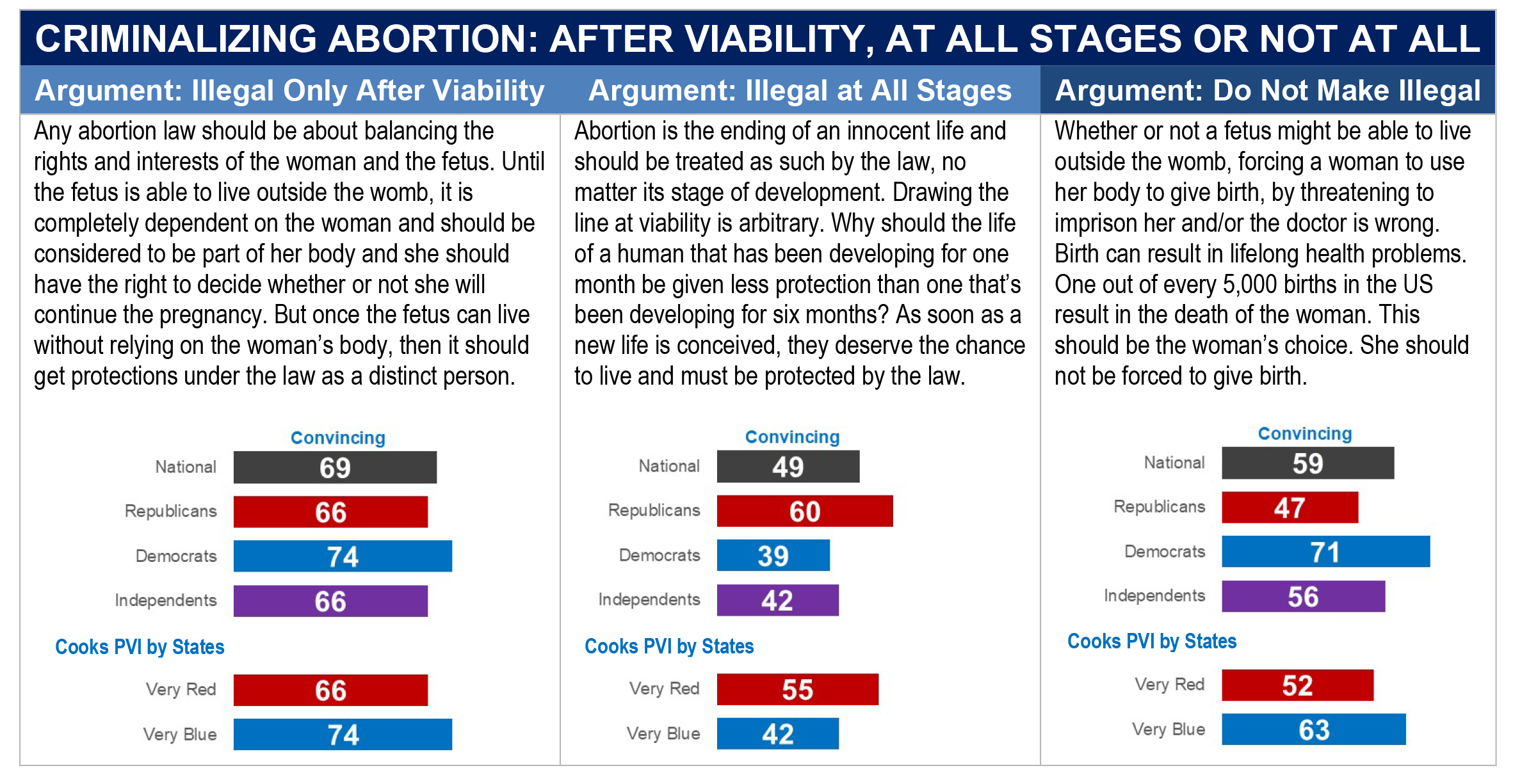 Punishing the Doctor or the Woman
Punishing the Doctor or the Woman
Naturally a key question is, if abortion is made a serious crime who should be punished in the event that an abortion is done.Respondents evaluated arguments for and against, punishing the doctor and/or the woman.
The first set of arguments were about punishing the doctor who performs the abortion. The argument in favor was found convincing by less than half (49%), including just 39% of Democrats, but a majority of Republicans (61%). The argument against was found convincing by a very large bipartisan majority (70%, Republicans 59%, Democrats 81%)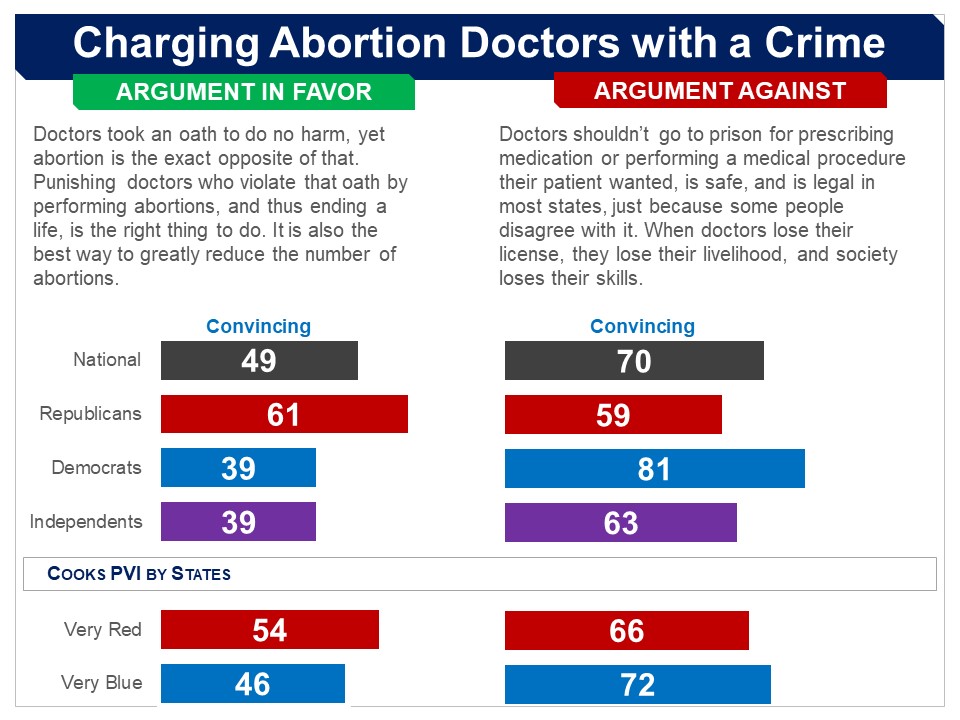 The next set of arguments were about punising the woman who gets the abortion. The argument in favor was found convincing by half (50%), including a majority of Republicans (63%), but just 39% of Democrats. The argument against was found convincing by a very large bipartisan majority (70%, Republicans 60%, Democrats 81%).
The next set of arguments were about punising the woman who gets the abortion. The argument in favor was found convincing by half (50%), including a majority of Republicans (63%), but just 39% of Democrats. The argument against was found convincing by a very large bipartisan majority (70%, Republicans 60%, Democrats 81%).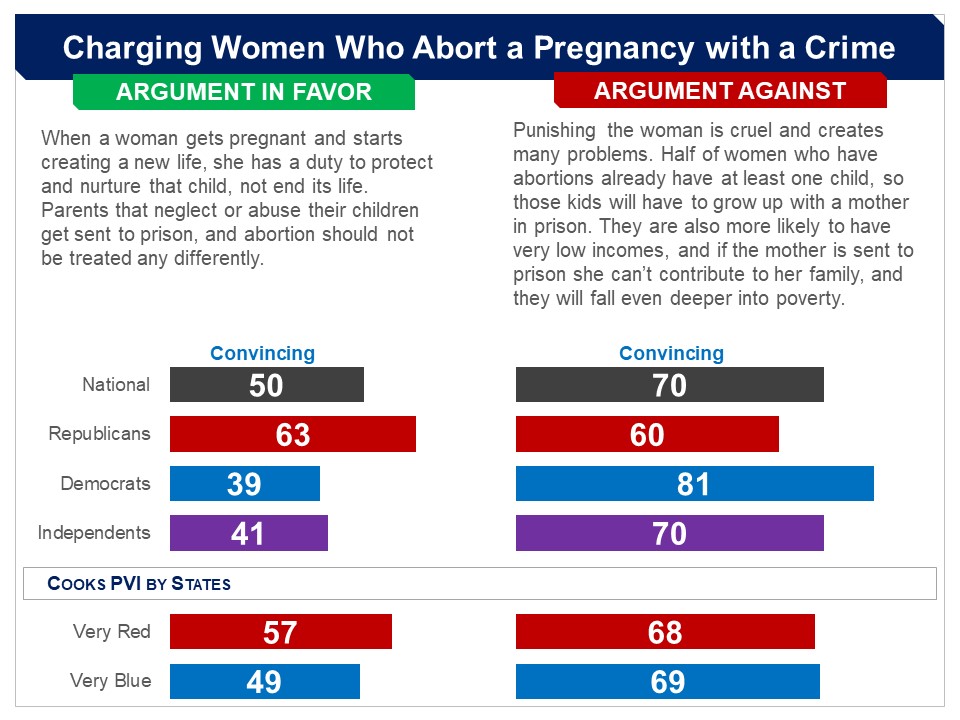






![]()
![]()
![]() Do not make abortion a crime, at any stage of pregnancy
Do not make abortion a crime, at any stage of pregnancy
Respondents were told how they would be making their final recommendations, as follows:
Now that you have considered the various options, we would like you to make your final recommendations on whether abortion should be a serious crime and if so under what circumstances.
If you do choose to make abortion a crime, you will then be given the chance to choose whether the law should punish the doctor and/or the woman; and whether there should be exceptions to that law.
Respondents were asked which of the following options they favor the most:
- Do not make abortion a crime
- Make abortion a serious crime after the fetus is viable (meaning it can very likely survive outside of the womb), with the punishment including prison time and/or major fines
- Make abortion a serious crime at any point during the pregnancy, with the punishment including prison time and/or major fines
The most popular position was not making abortion a crime at all which was favored by 57% overall, including 70% of Democrats and 64% of independents. Among Republicans, 42% were in favor and 64% found it at least tolerable (5-10 on an eleven-point scale measuring acceptability).
Another 27% favored making abortion a crime only after fetal viability, including 20% of Democrats, 35% of Republicans and 24% of independents.
The least popular position was making abortion a seroius crime at any point during the pregnancy, which was favored by just 14%, including 9% of Democrats, 21% of Republicans and 11% of independents.
Combining those who do not want to make abortion a crime with those who want to make a crime only after fetal viability, a large bipartisan majority of 84% did not want to make abortion a crime before viability (Democrats 90%, Republicans 77%, independents 88%).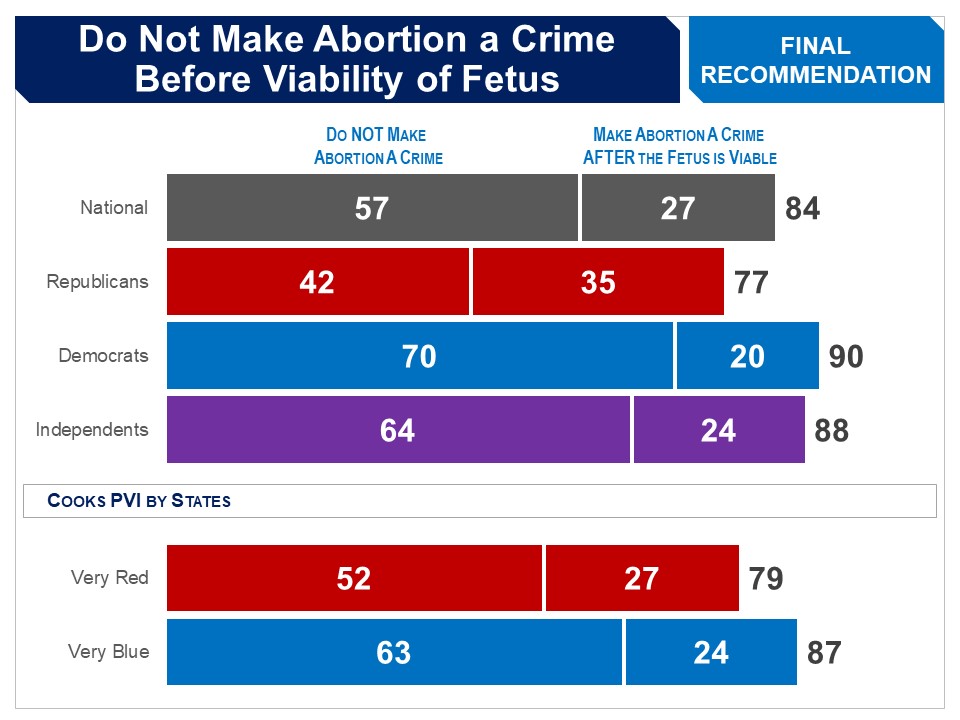
Across all of the different types of districts overwhelming majorities did not support making abortion a crime before fetal viability (very red 79%, very blue 87%). Smaller majorities went further and favored not making abortion a crime at all (very red 52%, very blue 63%).
Demographic and Partisan Differences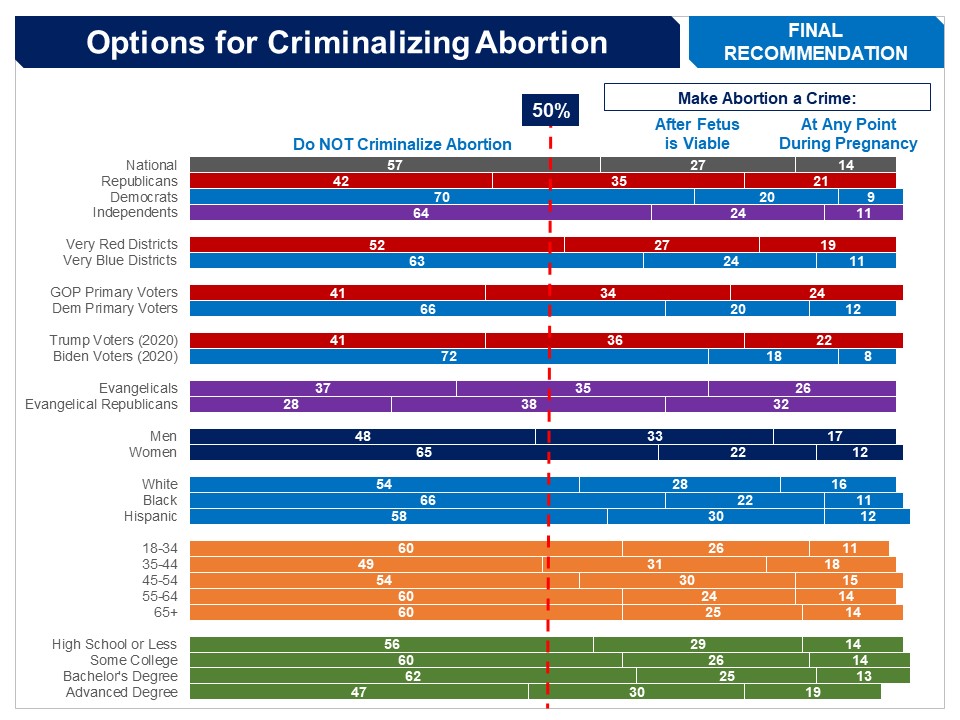 Views in States With Abortion Bans
Views in States With Abortion Bans
A separate analysis was done of respondents who live in the 15 states that have criminalized abortion at all stages of pregnancy, and are currently enforcing that law: AL, AK, ID, IN, IO, KY, LA, MS, MO, ND, OK, SD, TX, UT and WV.
Among such respondents, just 17% chose to make abortion a crime at all stages of pregnancy, just four percentage points higher than those those in states without total abortion bans (13%).
The majority in such states, instead, did not want criminalizing before viability (81%); and a slight majority did not want to make abortion a crime at all (52%).
The sample of respondents from Texas was large enough (n=233) that it could be analyzed separately. Texas voters overwhelmingly did want abortion to be criminalized before viability (84%), and 47% favored going further and not making abortion a crime at all.
Related Standard Polls
Standard polls can evoke what appear to be substantially different responses to the question of what role the government should play in relation to abortion. Looking more closely at the wording of the questions, though, it becomes clearer why there are these variations.
Questions about abortion elicit two key responses: how the respondent feels about abortion per se and how they feel about the government criminalizing abortion. As we have seen in this survey when presented the option of criminalizing abortion and making it clear that this means punishing the doctor and the woman, the overall majority is opposed, and a bipartisan majority is opposed to criminalizing before fetal viability.
This is consistent with other poll questions that explicitly state the actual policy consequences of making abortion illegal – prison time or fines for doctors or women. In this case support for making abortion a crime is less than half, overall and among both Democrats and Republicans:
- Asked whether they support or oppose, “a law that makes it a crime requiring fines and/or prison time for doctors who perform abortion,” just 21% were in support, including just 5% of Democrats and under half of Republicans (43%). (NPR/PBS NewsHour/Marist May 2022)
- Asked whether they support or oppose laws, “making it a crime for doctors to perform abortions that would result in either fines or prison time,” just 26% were in support, includng just 13% of Democrats and less than half of Republicans (47%). (Kaiser Family Foundation June 2022)
- Asked, in the same KFF poll, the same question about making it a crime for women to get abortions, just 20% were in support, including just 9% of Democrats and less than four-in-ten Republicans (36%).
Even when respondents were asked to consider a situation in which the abortion that is provided is illegal, there is no majority in support of the woman getting prison time or paying a fine/doing community service (16% and 14%, respectively); nor is there support for the doctor facing such penalties (prison 25%, fine/community service 18%). The doctor losing their license is supported by less than a third (31%). (Pew March 2022)
Other poll questions that do not make the implications of criminalization explicit have elicited very different responses. It appears that such elicit questions elicit attitudes about the government effectively taking a normative position of actively permitting abortion.
For example an NPR/PBS/Marist poll in May 2022 asked whether abortion should be “allowed” which implies the government taking a position of effectively endorsing abortion. In contrast to the large bipartisan majority of more than 8 in 10 that opposes criminalization before fetal viability, just 37% said it should be “allowed in the first six months” or available at any time.
A similar dynamic applies to questions that ask about making abortion “legal,” again implying that the government is taking an action to legalize, as opposed to taking an action to criminalize. In a May 2022 Quinnipiac poll only 37% favored making abortion “legal in all cases.” Far lower than the clear majorities who do not support making abortion a crime in the PPC and and other surveys.
Questions that ask about “banning” abortions also elicit support for a stronger response than ones that ask about criminalization. A June 2022 You/Gov Economist poll asked “at what point in a pregnancy do you think abortions should be banned?” This framed the question not as one of whether the abortion should be criminalized, but over what period beyond pregnancy the respondent would prefer to have abortions not occur. Respondents were nonetheless offered the option of saying that it should never be banned. Just 27% chose this option. Much lower than the majority that says that opposes criminalization.
Status of Legislation
A proposal to require that abortion remain legal up until fetal viability – effectively codifying the Roe v. Wade ruling is in the Reproductive Freedom for All Act (S. 4688) in the 117th Congress by Sen. Tim Kaine (D), Sen. Kyrsten Sinema (D), Sen. Lisa Murkowski (R) and Sen. Susan Collins (R)
The Women’s Health Protection Act, which included the same proposal along with other reproductive rights provisions, passed the House but was blocked from being voted on in the Senate. It was sponsored by Rep. Judy Chu (H.R. 8296) and Sen. Richard Blumenthal (S. 4132).



Several elected officials in states where abortions have been totally banned, have proposed passing laws to make it a crime to get an abortion in another state. Respondents were introduced to this proposal as follows:
As you may know, if a woman wants to get an abortion but it is illegal in her own state, she can travel to another state where it is legal and get an abortion.
In some states where abortions have been made a serious crime, some people are proposing laws making it a serious crime and punishing residents who go to another state to get to get an abortion that would have been illegal in her state of residence.
Because it is not yet clear if such a law would be constitutional, and because many respondents live in states without total abortion bans, respondents were asked “whether states should or should not be able to make such laws,” rather than if they favor or oppose such a law.
The argument in favor was found convincing by just under half (49%), including a majority of Republicans (57%), but less than half of Democrats (41%). The argument against was found convincing by a very large bipartisan majority (71%, Republicans 65%, Democrats 79%).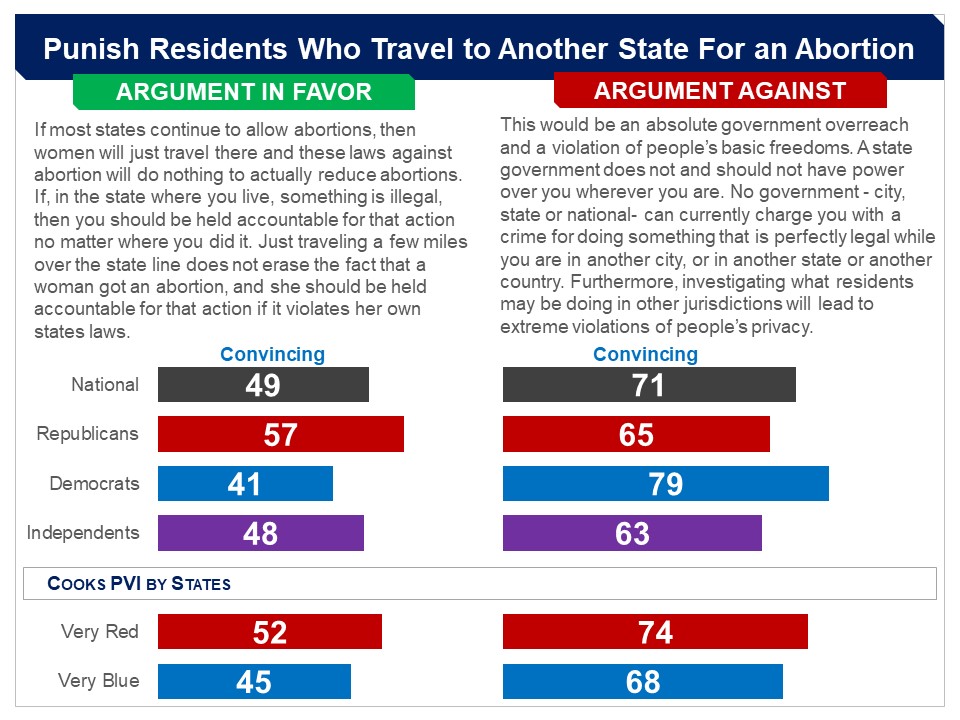
Asked for their final recommendation about whether states should or should not be able to “pass laws making it a serious crime and punishing residents who go to another state to get an abortion that would have been illegal in her state of residence,” a bipartisan majority said they should not be able to (62%, Republicans 53%, Democrats 67%). Majorities in all types of Congressional districts concurred (very red 58%, very blue 66%).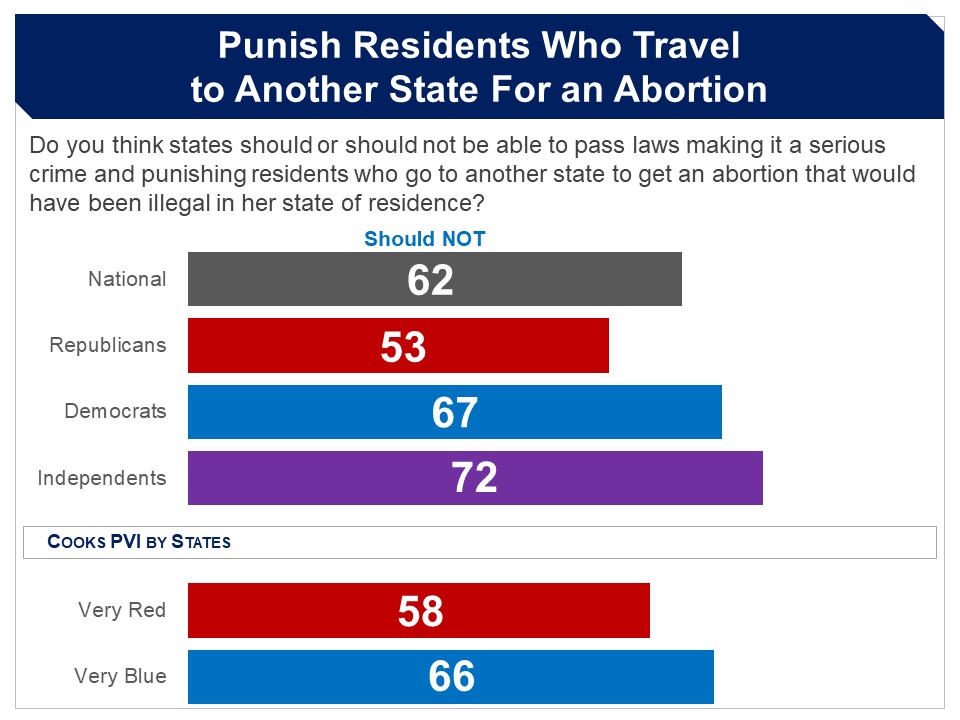 There was a significant variation between women and men: a very large majority of women (70%) said that states should not be able to punish residents for getting abortions in other states, while just around half of men agreed (52%).
There was a significant variation between women and men: a very large majority of women (70%) said that states should not be able to punish residents for getting abortions in other states, while just around half of men agreed (52%).
